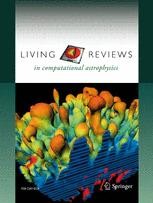Living Reviews in Computational Astrophysics: "Magnetic, thermal and rotational evolution of isolated neutron stars"
 Pons, J.A. & Viganò, D., "Magnetic, thermal and rotational evolution of isolated neutron stars", Living Rev Comput Astrophys (2019) 5: 3. https://doi.org/10.1007/s41115-019-0006-7
Pons, J.A. & Viganò, D., "Magnetic, thermal and rotational evolution of isolated neutron stars", Living Rev Comput Astrophys (2019) 5: 3. https://doi.org/10.1007/s41115-019-0006-7
Open Access | Review Article
First Online: 02 December 2019
Abstract:
The strong magnetic field of neutron stars is intimately coupled to the observed temperature and spectral properties, as well as to the observed timing properties (distribution of spin periods and period derivatives). Thus, a proper theoretical and numerical study of the magnetic field evolution equations, supplemented with detailed calculations of microphysical properties (heat and electrical conductivity, neutrino emission rates) is crucial to understand how the strength and topology of the magnetic field vary as a function of age, which in turn is the key to decipher the physical processes behind the varied neutron star phenomenology. In this review, we go through the basic theory describing the magneto-thermal evolution models of neutron stars, focusing on numerical techniques, and providing a battery of benchmark tests to be used as a reference for present and future code developments. We summarize well-known results from axisymmetric cases, give a new look at the latest 3D advances, and present an overview of the expectations for the field in the coming years.
The authors:
José Antonio Pons Botella is Professor in the Relativistic Astrophysics group of the Department of Applied Physics at the University of Alicante. He does research in in Computational Physics, Fluid Dynamics and Astrophysics.
Daniele Viganò currently is a Postdoctoral Researcher in the Relativity and Gravitationat group of the University of the Balearic Islands.
